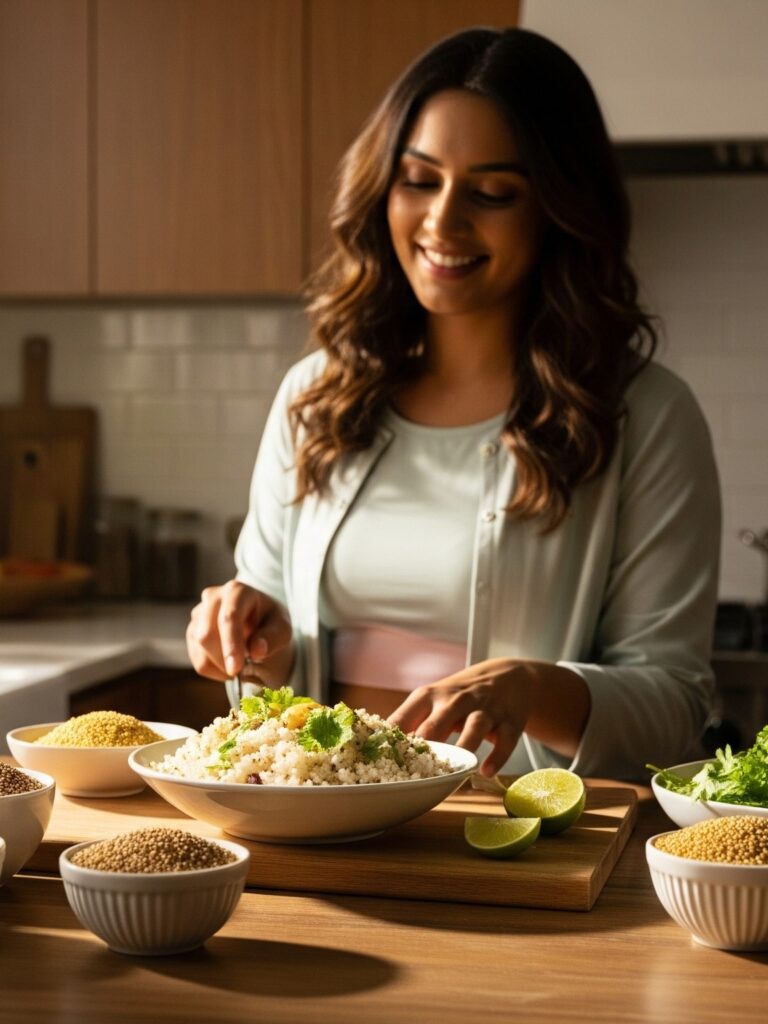The Indian PCOS diet that actually helps you lose weight even with hormonal imbalances
Medically Reviewed By
Aditya Khurana (MD, MBBS)
In this blog
What is GLP-1 and how does it work?
Week-by-Week breakdown
Tips and lessons from real users
The EARLY Perspective
Conclusion
About the Author
References
Ready to lose weight for good?
Polycystic Ovarian Syndrome (PCOS) affects millions of women, especially those in their teens and 20s, and if you’re dealing with it, you already know it’s more than just “hormonal issues.” From irregular periods and stubborn weight gain to acne and mood swings, PCOS doesn’t just impact reproductive health; it can disrupt everyday life.
A 2019 study found that 1 in 5 young Indian women are affected, and a 2022 meta-analysis revealed nearly 10% of Indian women overall may be living with it. The root cause? It’s still being researched, but poor lifestyle habits like unhealthy eating and lack of physical activity are common factors. Research and real-world experiences consistently show that a sustainable, nutrient-rich eating pattern can ease symptoms, balance hormones, and even support weight loss.
But here’s the hopeful part: your diet can be a total game-changer. And no, there are no quick fixes here. A diet is about nourishing your body in a way that supports your hormones, stabilises blood sugar, and makes you feel more in control.
Understanding PCOS and Weight
Women with PCOS often find it hard to lose weight, and there’s a reason for that. Hormonal imbalances, especially high insulin, and androgens, throw the body’s metabolism off track. When insulin doesn’t work well, the body produces more of it, which leads to fat gain, mostly around the belly. This, in turn, triggers more androgens, worsening symptoms like acne and irregular cycles.
Even losing about 5–10% of the body weight can make a real difference if you have PCOS. Studies show that this small but steady weight loss can improve your metabolism, balance hormones, boost mood and overall well-being. This highlights the importance of a healthy lifestyle, particularly a balanced diet.
How GLP-1 Helps PCOS?
GLP-1 medications help improve insulin sensitivity by slowing down digestion and making you feel full for longer, which naturally reduces how much you eat. For women with PCOS, using GLP-1 has been shown to lower fasting blood sugar, reduce triglycerides, and support weight loss, tackling one of the main issues behind PCOS, high insulin levels.
While off-label in many regions, these GLP-1 medications represent a promising adjunct to lifestyle modifications in a comprehensive PCOS management plan.
Best Indian Foods for PCOS
A healthy diet is important in managing PCOS. Dieting is not just about cutting calories. Research shows that low glycemic index (GI) diets can significantly improve insulin resistance, lower harmful cholesterol, reduce waist size, and even help balance male hormones like testosterone.
A balanced Indian PCOS weight loss diet checks all these boxes. It focuses on low-GI foods, anti-inflammatory ingredients, and nutrient-dense meals that support hormone health and stable blood sugar levels.
Let’s take a look at what you can add to your Indian PCOS weight loss diet and start building a plan that works for your body.
- Whole grains: Whole wheat, oats, and millets such as jowar, bajra, and ragi are rich in fiber and complex carbs. They digest slowly, keeping blood sugar levels stable and energy levels consistent.
- Lean proteins: Proteins like eggs, chicken, fish, tofu, and low-fat dairy support hormone production and help manage PCOS. If you have PCOS-related acne, keep dairy intake to no more than two servings a day.
- Spices and Herbs: Indian spices like turmeric, cinnamon, ginger, fenugreek, mint, and basil are rich in antioxidants and offer anti-inflammatory benefits that may help ease PCOS symptoms.
- Good Fats: Healthy fats like avocados, nuts, seeds, and coconut oil in your PCOS diet to support hormone balance. These good fats also boost heart health and aid in overall well-being.
- Pulses: Moong dal, chana dal, lentils, chickpeas, and soybeans are excellent plant-based protein sources with a low glycaemic index. They help regulate insulin levels while providing key nutrients like iron and folate for managing PCOS and supporting overall health.
- Vegetables: High-fibre veggies like leafy greens, broccoli, carrots, beans, and gourds to support better blood sugar control. These vegetables slow digestion and help improve insulin sensitivity in PCOS.
- Fruits: Whole fruits like berries, apples, and pears offer natural sugars and fibre that support blood sugar balance. Just remember to eat them in moderation, as large portions can still cause sugar spikes.
- Nuts and Seeds: A small portion of nuts and seeds, such as almonds, walnuts, flaxseeds, and pumpkin seeds, provides healthy fats that support hormone balance. Add them to meals or use them as toppings for extra nutrition.
Foods To Avoid with PCOD
Avoid or limit these foods to reduce inflammation, prevent insulin spikes, and support hormone balance: 6
- Fried foods: French fries, potato chips, fried chicken or fish
- Saturated fats: Butter, margarine, ghee in excess
- Red and processed meats: Beef, hot dogs, sausages, luncheon meat
- Refined carbs: White bread, pizza crust, rolls, white pasta, maida-based items
- Sugary cereals: Instant oats with added sugar, sweet granola
- Sugary snacks: Cakes, cookies, candy, pastries
- Sugary drinks: Sodas, sweetened teas, energy/sports drinks
- Alcohol: Especially cocktails and sweet wines
- White rice: Opt for brown rice or millets instead
3-Day Indian PCOS Diet Plan
What makes the Indian diet especially effective is its flexibility and variety. With the right tweaks, traditional meals can become powerful tools for managing PCOS naturally. Below is a 3-day Indian PCOS diet you can follow to lose weight healthily.
Note: Always consult a registered dietician or healthcare provider before starting any new diet plan. Individual nutritional needs may vary based on health conditions and lifestyle.
| Day | Breakfast | Mid-meal | Lunch | Evening | Dinner |
| 1 | Vegetable poha+ low-fat milk ½ cup. | A portion of low-glycemic fruit | 2 Chapati+ ½ cup beans subji+ Chicken curry (100g) 1/2 cup. | 1 cup tea and 2 digestive biscuits | 2 Rotis + a cup of subji of choice. |
| 2 | Vegetable Oats Upma 1 cup+ low fat milk ½ cup. | A portion of low-glycemic fruit | 1 cup cooked rice + ½ cup dal (lentils) + ½ cup spinach curry + ½ cup low-fat curd. | 1 cup tea and 2 digestive biscuits | 2 rotis (chapatis) + ½ cup okra (bhindi) subji. |
| 3 | 2 slices whole-wheat brown bread + 1 slice low-fat cheese + 2–3 boiled egg whites | ½ cup boiled black chana + 3–4 walnut halves | 1 cup brown rice veg pulao + ½ cup soya-chunk curry + 100 ml buttermilk | 1 small orange or ½ cup papaya + 1 tsp chia seeds (optional) | 1 cup broken-wheat upma with vegetables + ½ cup veg raita |
Lifestyle Strategies for Hormonal Balance
Beyond diet, simple daily lifestyle tweaks can amplify results in an Indian PCOS weight loss diet approach. Some lifestyle hacks to follow include.
- Exercise regularly for 30–45 minutes a day
- Sleep for 7–8 hours every night to support hormonal balance
- Manage stress through yoga, meditation, or deep breathing
- Take supplements as prescribed by your doctor
- Limit junk food intake to reduce inflammation and insulin spikes

About the Author
Arwa Aliakber
Arwa Aliakber is a qualified pharmacist and seasoned health & wellness writer with 4+ years of experience delivering high-impact content for global healthcare brands. She has worked with startups, pharmaceutical companies, hospitals, and digital agencies, translating complex medical information into clear, engaging, and trustworthy content.
References
- Vos T, et al. (2020)
https://doi.org/10.1016/S0140-6736(20)30925-9 - Hoy D, et al. (2014)
https://ard.bmj.com/content/73/6/968 - Messier SP, et al. (2005).
https://onlinelibrary.wiley.com/doi/10.1002/art.21342 - Pal CP, et al. (2016).
https://www.sciencedirect.com/science/article/pii/S0976566215001078 - Shiri R, et al. (2010).
https://academic.oup.com/aje/article/171/2/135/135233 - NFHS-5 (2021). http://rchiips.org/nfhs/NFHS-5_FCTS/India.pdf
In this blog
Understanding PCOS and Weight
How GLP-1 Helps PCOS?
Best Indian Foods for PCOS
Foods To Avoid with PCOD
3-Day Indian PCOS Diet Plan
Lifestyle Strategies for Hormonal Balance




